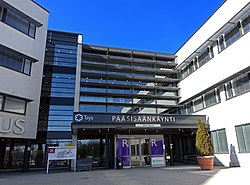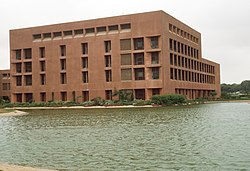
A teaching hospital or university hospital is a hospital or medical center that provides medical education and training to future and current health professionals. Teaching hospitals are almost always affiliated with one or more universities and are often co-located with medical schools. [1] [2] [3]
Contents
- History
- Definitions
- Research
- By region
- Africa
- Asia
- Europe
- North America
- Oceania
- See also
- References
- Further reading
Teaching hospitals use a residency program to educate qualified physicians, podiatrists, dentists, and pharmacists who are receiving training after attaining the degree of MD, DO, DPM, DDS, DMD, PharmD, BDS, BDent, MBBS, MBChB, or BMed. [4] [5] [6] [7] [8] Those that attend a teaching hospital or clinic practice medicine under the direct or indirect supervision of a senior medical clinician registered in that specialty, such as an attending physician or consultant. The purpose of these residency programs is to create an environment where new doctors can learn to practice medicine in a safe setting which is supervised by physicians that provide both oversight and education.



